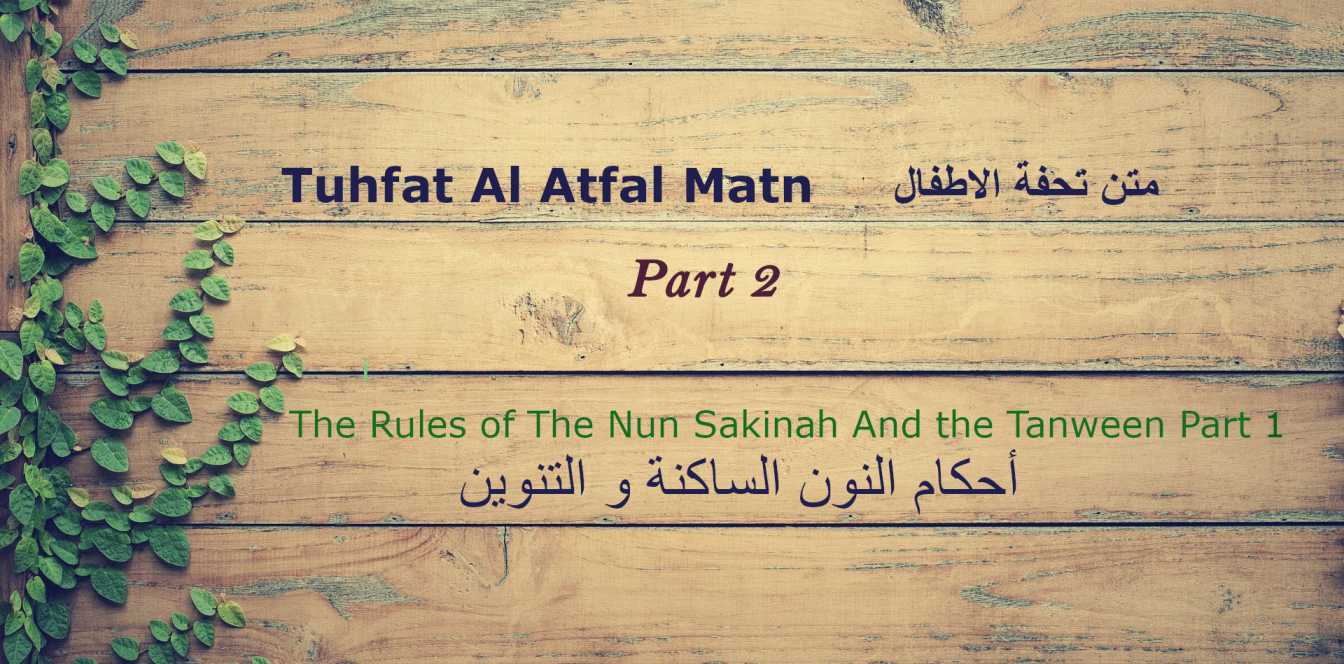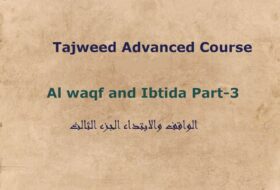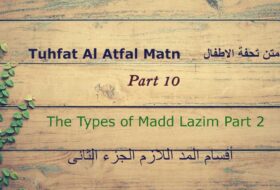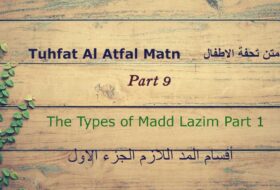The Rules of the Noon Sakinah and the Tanween Part 1
See:-> Part-1 Part-3 Part-4 Part-5 Part-6 Part-7 Part-8 Part-9 Part-10 Part-11
أحكام النون الساكنة و التنوين
للنُّـون إنْ تَسكُــنْ وَللتَّنْــــوِينِ أَرْبَـعُ أَحْكَـامٍ فَخُذْ تَبيِيِنـــي
فَـالأَوّلُ الإِظْـــهَارُ قَبْلَ أَحْـــرُفِ للحَلْقِ سـتَّ رُتَّبَتْ فَلْتَعْــرِفِ
هَمْــزٌ فَهـَاءٌ ثُمَّ عَيْنٌ حَـــــاءُ مُهْمَلَتَــانِ ثُـمَّ غَيْنٌ خَــاءُ
والثَّـانِ إِدْغَـامٌ بِسَتَّـــة أتـــَتْ فِي يَرْمُلـُونَ عِنـْدهُم قَدْ ثَبَتتْ
لَكنَّهَـا قِسْمــانِ قسْــمٌ يُدْغَمَــا فِيــِه بِغُنَّـةٍ بِيَنمُـو عُلِمَــا
إِلا إذَا كَــانَا بِـكلْمَـةٍ فَـــــلا تـُـدْغِمْ كَـدُنْيَا ثُمَّ صِنْوَانٍ تَلا
TEXT: 6
للنُّـون إنْ تَسكُــنْ وَللتَّنْــــوِينِ أَرْبَـعُ أَحْكَـامٍ فَخُذْ تَبيِيِنـــي
VOCABULARY:
للنُّـون – for the noon
إنْ تَسكُــنْ – when it has a Sukun; it is unvowelled or vowelless.
وَللتَّنْــــوِينِ – for the Tanween
أَرْبَـعُ – four
أَحْكَـامٍ – rules
فَ – so
خُذْ – take
تَبيِيِنـــي – my explanation
TRANSLATION:
6. For the noon, when it has a Saakin, and for the Tanween there are four rules, so take my explanation (thereof).
COMMENTARY:
The author mentions that there are four rules regarding the Noon Saakina and the Tanween . In the lines that follow, he offers his explanation of these four rules:
- Al-ITH-HAAR(Al-HALIQE) الإظهار الحلقى
- Al-IDGHAM(NOON SAKINAH) الإدغام
- Al-IKHFAA’ AL-HAQIQI الإخفاء الحقٌيقى
- Al-IQLAB(NOON SAKINAH) الإقلابَ
TEXT: 7
فَـالأَوّلُ الإِظْـــهَارُ قَبْلَ أَحْـــرُفِ للحَلْقِ سـتَّ رُتَّبَتْ فَلْتَعْــرِفِ
VOCABULARY:
فَـالأَوّلُ – The first
الإِظْـــهَارُ – Al-ITH-HAAR
قَبْلَ – before
أَحْـــرُفِ – letters. The plural of حرف letter
للحَلْقِ – for the throat
سـتَّ – six. It can be read as ست There is not much difference in the meaning.
رُتَّبَتْ – arranged (in order or sequence). It refers to ست ِ Before it.
فَلْتَعْــرِفِ – so know them (these six letters of the throat). This word can also be read as فلتعرفى .Its meaning would then be: let them be known .
TRANSLATION:
7. So, the first (of the four rules) is Al-ITH-HAAR , before the letters of the throat which are six, arranged in order (of their Makharij from the lower throat upwards), so know them.
COMMENTARY:
The first of the four rules is iṭḥ-hār. It literally means ‚clear‛. If the Noon Saakina appears before any of the six letters of the throat, then ITH-HAAR will take place; it will be read clearly without any extra nasal pull.
In some prints قبل احرف with replaced withقبل احرف The first is more common and is relied on In the following line, the letters of the throat are mentioned in their order of pronunciation from the lower throat upwards.

TEXT: 8
هَمْــزٌ فَهـَاءٌ ثُمَّ عَيْنٌ حَـــــاءُ مُهْمَلَتَــانِ ثُـمَّ غَيْنٌ خَــاءُ
VOCABULARY:
ثُـمَّ – then
مُهْمَلَتَــانِ – referring to the ʿAyh and the ḥāʾ.The word مهملة means dotless or without dots (diacritical marks).
TRANSLATION:
8. The Hamzah and the haʾ, then the Ayn and the ḥa which lack dots and then the ghayn and the kha.
COMMENTARY:
In this line, the six letters of the throat are mentioned. Thus if a Noon Sakinah or Tanwin appears before any of these letters, iṭḥ-har will take place .
TEXT: 9
والثَّـانِ إِدْغَـامٌ بِسَتَّـــة أتـــَتْ فِي يَرْمُلـُونَ عِنـْدهُم قَدْ ثَبَتتْ
VOCABULARY:
والثَّـانِ – second the
إِدْغَـامٌ – idgham
بِسَتَّـــة – in six (letters)
أتـــَتْ – appear, take place, occur
فِي يَرْمُلـُونَ – This combination indicates to/holds all the letters of idgham
عِنـْدهُم – according to them (the qurraat)
قَدْ – verily , surely
ثَبَتتْ – established , Fixed
TRANSLATION:
9. And the second (rule) is idgham in six (letters), appearing in (combination the which are fixed by them (the qurrāʾ – as يَرْمُلـُونَ the letters of idgham)
COMMENTARY:
The second rule the author explains to us is idghām, which literally means to assimilate or to join one thing into another. In this case, the Noon Sakinah or Tanween will be assimilated into one of the of letters يَرْمُلـُونَ if they appear after the Noon Saakinah or Tanween .
He further adds that these six letters are affirmed amongst qurraʾ as the letters of idghām i.e. all the qurrāʾ agree that idgham of Noon Saakinah or Tanween .will take place into these six letters.
TEXT: 10
لَكنَّهَـا قِسْمــانِ قسْــمٌ يُدْغَمَــا فِيــِه بِغُنَّـةٍ بِيَنمُـو عُلِمَــا
VOCABULARY:
لَكنَّهَـا – but they (these six letters)
قِسْمــانِ – two types
ٌقسْــمٌ – part or type (one). The singular of قِسْمــانِ
يُدْغَمَــا – idghaam will be made
فِيــِه – in it (this type)
بِغُنَّـةٍ – ِwith ghunnah. Ghunnah is the nasal sound found in every Noon and Meem.
بِيَنمُـو – ِin (the letters of) يَنمُـو
عُلِمَــا – they (the letters) are known.
TRANSLATION:
10. But they (these six letters) are of two types: one, in which idghām takes place with ghunnah. It is known (remembered) by يَنمُـو
COMMENTARY:
The author divides the six letters of idgham into two types: those letters in which idghām takes place with ghunnah, and those letters in which idghaam takes place without ghunnah. In this line, he explains the first type: idghām with gunnah. Idghām will take place with ghunnah in the four letters of يَنمُـو if they appear after the Noon Saakinah or Tanween .
TEXT: 11
إِلا إذَا كَــانَا بِـكلْمَـةٍ فَـــــلا تـُـدْغِمْ كَـدُنْيَا ثُمَّ صِنْوَانٍ تَلا
VOCABULARY:
إِلا – except
إذَا – if
كَــانَا – the two of them. It refers to the mudgham which would be the Noon Sakina or the Tanween, and the mudgham fīh which would be one of the letters of يَنمُـو In some prints it appears as كان without the Alif at the end. In this case it would only refer to the mudgham (the Noon Sakina or the Tanween).
بِـكلْمَـةٍ – in one word. It may be read with a fatḥah or kasrah on the kaf. The meaning will remain the same.
فَـــــلا تـُـدْغِمْ – then don’t make idghām. It can be read with a fatḥah on the ghayn also تـُـدْغِمْ ;(its meaning would then be: then idghām won’t be made .
كَـ – like
دُنْيَا ثُمَّ صِنْوَانٍ – examples for no idgham
تَلا – to follow. It hints at other examples, which follow the same pattern.
TRANSLATION:
11. Except if the two (mudgham and mudgham fīh) appear in one word, then do not make idgham like (in the words) thenُ صِنْوَانٍ and (examples that) follow (suit).
COMMENTARY:
In the previous line it was stated that if Noon Sakina or the Tanween appear before any of the letters of يَنمُـو idghām would be made with ghunnah. However, in this line the author mentions that if the Noon Sakinah is followed by any one of these letters in one word, then idgham will not be made.
In other words, idgham of Noon Sakinah into any of the letters of يَنمُـو will only take place if they appear in two separate words; the Noon Sakinah at the end of a word and one of the letters of يَنمُـو at the beginning of the next. If they appear together in one word idghām will not take place.
This will only apply to the Noon Sakinah and not to the Tanween , due to a Tanween always appearing at the end of a word; therefore it is impossible that a Tanween is followed by one of the letters of يَنمُـو in one word.
The author explains that idghām will not be made but does not explain what application should be used in its absence. However, in Jamzari’s explanation of the Tuḥfah, he states that iṭḥ-haar will be made instead.














Comments